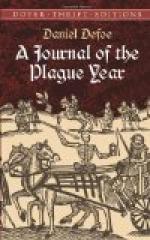We had no such thing as printed newspapers in those days, to spread rumors and reports of things, and to improve them by the invention of men, as I have lived to see practiced since. But such things as those were gathered from the letters of merchants and others who corresponded abroad, and from them was handed about by word of mouth only; so that things did not spread instantly over the whole nation, as they do now. But it seems that the government had a true account of it, and several counsels[5] were held about ways to prevent its coming over; but all was kept very private. Hence it was that this rumor died off again; and people began to forget it, as a thing we were very little concerned in and that we hoped was not true, till the latter end of November or the beginning of December, 1664, when two men, said to be Frenchmen, died of the plague in Longacre, or rather at the upper end of Drury Lane.[6] The family they were in endeavored to conceal it as much as possible; but, as it had gotten some vent in the discourse of the neighborhood, the secretaries of state[7] got knowledge of it. And concerning themselves to inquire about it, in order to be certain of the truth, two physicians and a surgeon were ordered to go to the house, and make inspection. This they did, and finding evident tokens[8] of the sickness upon both the bodies that were dead, they gave their opinions publicly that they died of the plague. Whereupon it was given in to the parish clerk,[9] and he also returned them[10] to the hall; and it was printed in the weekly bill of mortality in the usual manner, thus:—
Plague, 2. Parishes infected, 1.
The people showed a great concern at this, and began to be alarmed all over the town, and the more because in the last week in December, 1664, another man died in the same house and of the same distemper. And then we were easy again for about six weeks, when, none having died with any marks of infection, it was said the distemper was gone; but after that, I think it was about the 12th of February, another died in another house, but in the same parish and in the same manner.
This turned the people’s eyes pretty much towards that end of the town; and, the weekly bills showing an increase of burials in St. Giles’s Parish more than usual, it began to be suspected that the plague was among the people at that end of the town, and that many had died of it, though they had taken care to keep it as much from the knowledge of the public as possible. This possessed the heads of the people very much; and few cared to go through Drury Lane, or the other streets suspected, unless they had extraordinary business that obliged them to it.
This increase of the bills stood thus: the usual number of burials in a week, in the parishes of St. Giles-in-the-Fields and St. Andrew’s, Holborn,[11] were[12] from twelve to seventeen or nineteen each, few more or less; but, from the time that the plague first began in St. Giles’s Parish, it was observed that the ordinary burials increased in number considerably. For example:—




